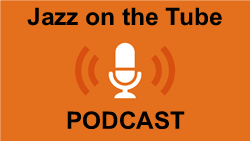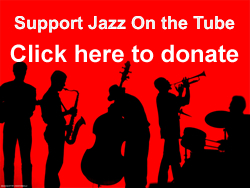Duke Ellington
Jazz On The Tube Radio
Tribute
Duke Ellington
Edward Kennedy Ellington was born on April 29, 1899 in Washington, D.C. Duke’s mother was the daughter of a slave and while Duke was growing up she would surround him with very conservative women to teach him the manners and lifestyle that fell in line with this image. Ellington’s manner and way of being at such a young age caused his childhood friends to begin calling him ‘Duke’. Duke began taking piano lessons at the age of seven though he was much more interested in baseball at this point in his life. When Ellington began sneaking into a local poolroom in his teens he heard piano players there and fell in love with the instrument and began taking it more seriously. While in high school Duke studied harmony privately with his high school music teacher and also took lessons with local pianist Oliver ‘Doc’ Perry. Duke also cites James P. Johnson, Luckey Roberts, Fats Waller, Marion Cook and Sidney Bechet as influences. In 1917 Duke began playing professionally at night while painting commercial signs during the day. In 1919 he formed his first formal group, The Duke’s Serenaders, with Otto Hardwick, Elmer Snowden, Arthur Whetsol and Sonny Greer.
When Sonny Greer was asked to move to New York to join the Wilbur Sweatman Orchestra, Duke decided it was time for him to make the move as well and moved to Harlem. It was difficult to make ends meet at first and Willie ‘The Lion’ Smith helped out Duke and his band mates by introducing them to people on the scene and helping financially. Duke landed a gig at the Exclusive Club in Harlem which was followed by a four year engagement at the Hollywood Club in 1923 which later became known as the Club Kentucky. At this point the group was known as Elmer Snowden and his Black Sox Orchestra and after Snowden left they became The Washingtonians and Duke took over as band leader. In 1927 King Oliver passed up an offer to be the house band at the Cotton Club in Harlem and the gig was then given to Ellington. Between a weekly radio broadcast and a high profile clientele this engagement put Duke on the map. From 1927 until 1939 Ellington made a deal for Irving Mills to become his agent and publisher and Mills helped make Duke much more popular by brokering deals with several record companies and promoting the Ellington and the band. In 1933 Duke and the band toured England and in ’34 around Europe and this made Ellington an international star. Some of the great songs composed by Ellington in the 1930s that remain standards today include ‘Satin Doll’, ‘Mood Indigo’, ‘Sophisticated Lady’, ‘Caravan’, ‘Solitude’, ‘It Don’t Mean a Thing (If it Ain’t Got That Swing)’ and ‘In a Sentimental Mood’. In 1939 Duke began working with Billy Strayhorn, a pianist, composer and arranger with a classical background, and together they would form one of the most famous Jazz working relationships with Strayhorn almost providing a double for Ellington with arrangements as well as at the piano.
Up until this point Ellington found himself restricted as a composer by the length of records and often having to keep songs less than three minutes. One of Duke’s personal aspirations was to extend this form in Jazz and allow for more possibilities. In the 1940s Ellington began doing this and his first well known composition of this kind was ‘Black, Brown and Beige’ in 1943 which he debuted at Carnegie Hall. This piece of music told the story of African-Americans in this country focusing on the pain caused by slavery and the peace they found in church. As Jazz moved into its’ bebop movement and younger kids were starting to lean towards Rhythm and Blues it became more difficult for Ellington to keep his orchestra going. Duke loved having the orchestra and the ability to present his music with such instrumentation so much that more often than not the income brought in was just enough to keep things going. Ellington continued following his vision and composed ‘Harlem’ in 1950 and presented then President Truman with the score.
After a difficult period in the early 1950s Ellington put himself back on the map with a performance at the Newport Jazz Festival in 1956 featuring the tune ‘Diminuendo and Crescendo in Blue’ with Paul Gonsalves’ famous six minute saxophone solo and was made into a record released the following year entitled ‘Ellington at Newport’. After this Duke composed ‘Such Sweet Thunder’ in 1957 based on a story in Shakespeare and ‘The Queen’s Suite’ dedicated to Queen Elizabeth II. Ellington aired a live performance on CBS featuring his suite ‘A Drum Is a Woman’ in ’57 along with performing at the Monterey Jazz Festival and a tour of Europe in ’58. In the late 1950s Ellington and Strayhorn began working on film scores together and some of these include ‘Anatomy of a Murder’, ‘Paris Blues’, an adaptation of John Steinbeck’s novel ‘Sweet Thursday’ and the ‘Nutcracker Suite’. In the 1960s Duke recorded with a number of greats in Jazz for the first time including Count Basie, Coleman Hawkins, John Coltrane, Charles Mingus, Max Roach and Frank Sinatra. Ellington continued composing as well and some pieces include ‘Far East Suite’, ‘New Orleans Suite’, ‘The Afro-Eurasian Eclipse’ and his series of sacred concerts combining Jazz and Christian liturgy. Duke Ellington kept going strong till the end and passed away in 1974 and his funeral was attended by over 12,000 people.
Ellington leaves a legacy as one of America’s greatest composers, helped spread Jazz internationally and created a song book that remains in use to this very day. Duke’s work as a whole is truly beyond any genre and is one of the first great examples of why Jazz music is a truly sophisticated art form encompassing the technical mastery of classical music and even moving beyond that to also encompass the true nature of life itself with improvisation. Just a few of the many awards Duke has received include thirteen Grammy Awards, featured on the Washington D.C. commemorative quarter dollar, the U.S. Postal Service issued a stamp in his honor, Presidential Medal of Freedom, French Legion of Honor, Down Beat Jazz Hall of Fame and the NAACP Spingarn Medal. Duke Ellington and his music will be remembered and celebrated for a very, very, very long time.
“Art is dangerous. It is one of the attractions: when it ceases to be dangerous you don’t want it.”
“Jazz is music; swing is business.”
“The writing and playing of music is a matter of intent…. You can’t just throw a paint brush against the wall and call whatever happens art. My music fits the tonal personality of the player. I think too strongly in terms of altering my music to fit the performer to be impressed by accidental music. You can’t take doodling seriously.” – Duke Ellington
[tell-a-friend id=”1″ title=”Tell a friend”]





